
Please find below a guest post from Nathan Webb on the latest AFG mortgage finance figures, released earlier this week.
AFG have released their July Mortgage sales report, and they are highlighting the positive – “Strongest July in 5 years”. Yes, but that’s not saying much. More importantly, after adjusting for the number of weekdays and for seasonal variations, this was the worst result since January. It looks like the housing recovery is running out of steam, almost before it has started.
What happened to those interest rate cuts? Some might say that they take time to take effect. I would say that they already have, just not in ways that most people expected. Changes to interest rates by central banks are designed to do one of three things (or a combination of these):
- Allow people to borrow more, leading to greater consumption (the credit-positive outcome, aka leveraging)
- Reduce the interest burden that people have, freeing up spare-cash and leading to greater consumption (the credit-neutral outcome)
- Free up spare-cash by reducing the interest burden, which can be used to pay off debt (the credit-negative outcome, aka deleveraging).
In his June speech, “The Glass Half Full”, Glenn Stevens was pretty clear in his view as to which of the three Australia was now heading towards:
“I do not think we should set monetary policy to foster a renewed gearing up by households. We can help, at the margin, the process of borrowers getting their balance sheets into better shape. … The reduction in interest rates over the past eight months or so … will speed up, at the margin, the process of deleveraging for those who need or want to undertake it.”
So if that’s the case, then we should expect to see an acceleration of deleveraging, and no pick-up in mortgage sales.
But back to the AFG mortgage volumes. The first chart shows the overall view, comparing the actual volumes recorded by AFG along with the predicted volumes. The prediction is based solely on the number of trading days, and seasonal variations in December and January. You can just make out a bit of whitespace developing at the far right between the red line and green bars. That kind of gap, as experienced in 2010 and early 2011, leads to significant price falls. Compare that to 2007 and 2009, when the red line is below the bars. That led to price rises.
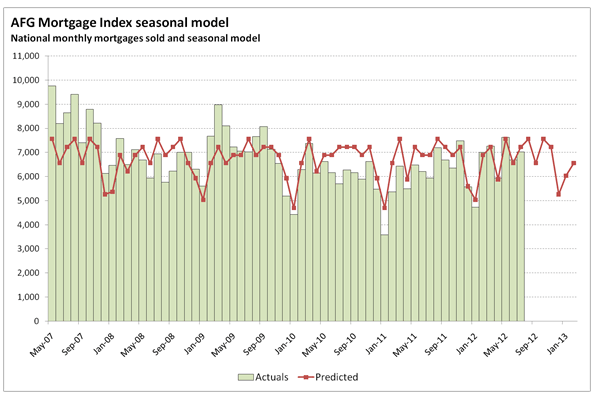
The chart also makes it clear that the raw figures over the next few months will be up and down. More than ever it is important to look through the headlines and concentrate on the adjusted figures.
The second chart is a plot of the difference between the green bars (actual) and the red line (predicted). This gap is referred to as the “residual”. Periods like 2010 lead to large negative values, while 2007 and 2009 caused large positive values.
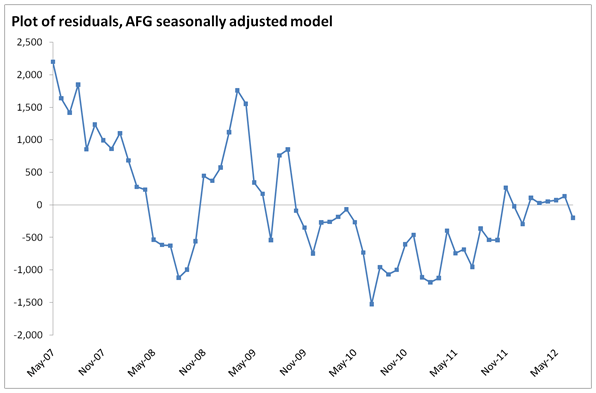
Normally I don’t worry about excluding the refinancing figures, as it doesn’t usually affect the message. But last month was different as the ex-refinancing volumes had diverged from the total volumes, and to the downside. Either this was a one-off, and it would bounce back in July, or total sales would follow shortly thereafter. We now know that it is the latter. After a good first half of the year, mortgage sales look to be rolling over. It’s not much yet, and is still pointing towards flat prices by the end of the year, but it’s the first negative result in 6 months.
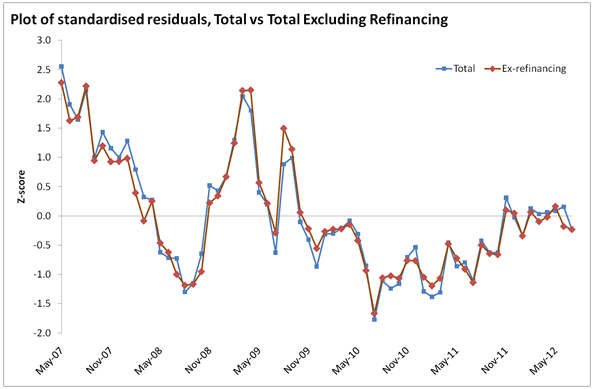
The residuals are then compared to SQM’s stock on market report, where there is a very strong negative correlation. The third chart shows this, with the residual inverted and laid over the top of the change in Stock on Market. I’ve used the 3 month moving average to smooth things out. The AFG results lead the 3mma by 1 month. July’s stock on market fell a lot, by 20,000, but the forecast is for it to start heading up again.
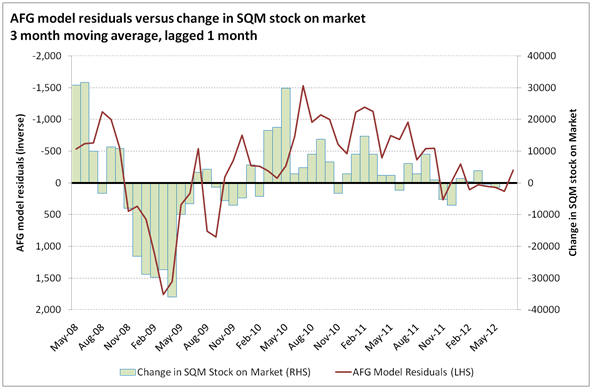
The correlation with RP Data’s house price index is also pretty good, with a notable exception being May 2012. That month is still having an impact on the next chart. June and July have been much stronger than predicted, however, so next month will probably see a tall bar to balance it out. This pattern of extreme volatility should be expected to continue, thanks to the new daily series.
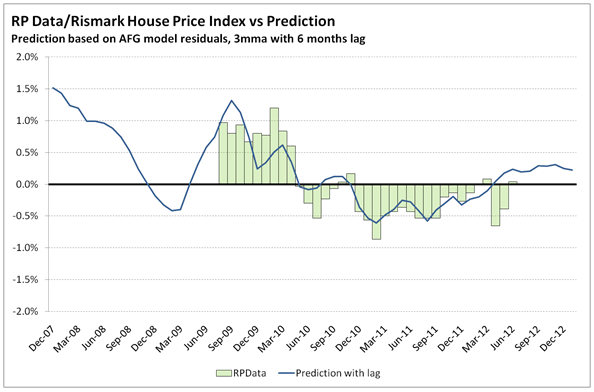
To round off the numbers, the ABS also provided their view of house prices. One of the key facts from this release was that the first quarter was revised upwards from -1.1% to -0.1%. This is still subject to further revision, and I expect it to be revised upwards again, to a positive number. The December quarter was also revised upwards, as expected, from -1% originally, to -0.7% and finally to -0.6%. The June quarter came in slightly below the prediction, at 0.5% compared to 0.58% predicted.
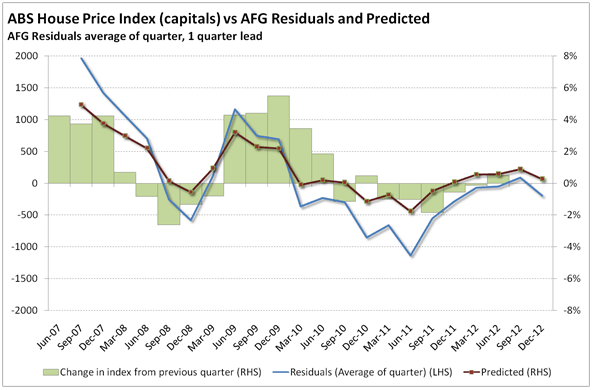
Looking ahead, the prediction is for alternating periods of very strong positive and negative price changes, averaging out to around 0 – 2% in nominal terms over the next 6 months. The growth rate is expected to peak between September and November, before it starts to head down. If the next few months see further poor data out of AFG, then 2013 might start to see some consistently negative results.
But before I get too ahead of myself, there are some reasons not to get too excited, one way or the other:
- There’s not much history, as I only have RP data records only going back to 2009. The correlation going forward might not be as good as it has been recently.
- The residual in July is only slightly negative, at 200 below expectation. This could be due to random variation. Look for a drop of 500 or more for any serious price action.
- Including the ex-refinancing figures, we’ve only had two months of poor results so far, which isn’t nearly enough to establish a solid trend.

